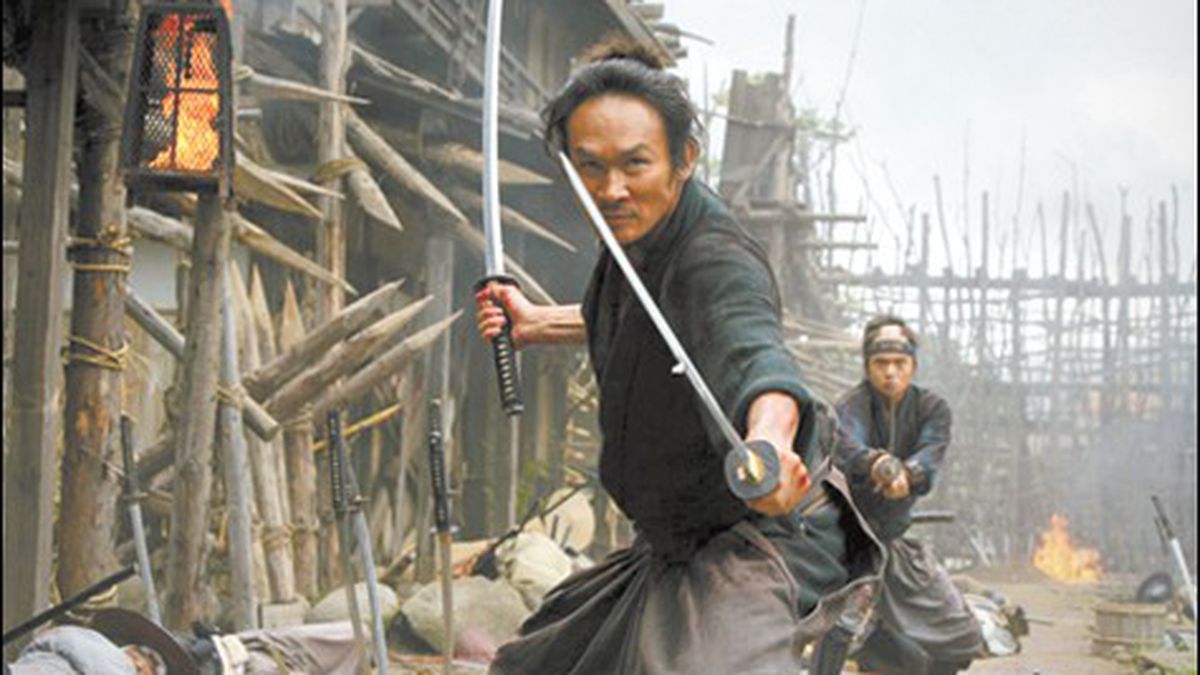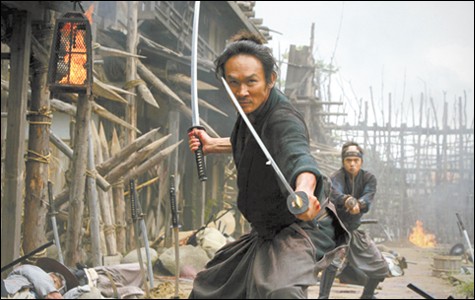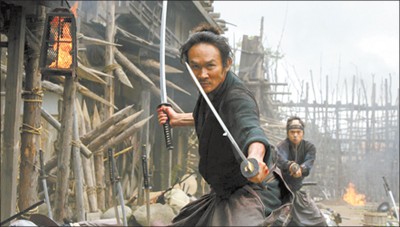Takashi Miike — is he one of Japan’s most provocative filmmakers, or just an opportunistic creator of shock spectacles who managed to ride the audience’s taste for graphic violence to a successful, if somewhat dubious, career?
We only pose that question because much of the publicity for Miike’s latest, the samurai adventure 13 Assassins, dwells on the film’s climactic sword fight, a 45-minute marathon of slice ‘n’ dice seemingly intended to put the fifty-year-old director once more at the forefront of a certain category of top-this cinematic mayhem vendors. It’s only fair to question the ultra-prolific Miike’s motives at this stage of his career. That final battle royale is indeed a whopper. On closer inspection, however, the deeper we go into 13 Assassins the more rewarding it becomes.
Ostensibly a remake of Eiichi Kudo‘s 1963 film Jûsan-nin no shikaku, Miike’s version takes us to the year 1844, in which the chaotic, incessant warfare of Japan’s feudal era has long since given way to the uneasy central control and iron-fisted cruelties of the Tokugawa Shogunate. One member of the elite in particular, Lord Naritsugu Matsudaira (played by Gorô Inagaki in a shower of sadistic vanity), the shogun’s younger brother, has abused his power atrociously — raping, mutilating, and killing unfortunate commoners to such an extent that even his subordinates are ashamed to be associated with him. His actions are disgracing the government.
It is decided by a rival official of the Shogunate that Naritsugu should be eliminated with extreme prejudice, and that one Shinzaemon Shimada (Kôji Yakusho), a samurai of integrity, should assemble a strike force to do the job. Shimada rounds up a stalwart band of killers to ambush Naritsugu and his Akashi clan retinue as they pass through a village en route to the capital, Edo (now Tokyo). Thirteen heroic men, whose motto apparently is “He who values his life dies a dog’s death,” against 200 heavily armed soldiers. Standard odds for a chanbara (sword fight) movie.
Of course, with Miike we hardly expect a standard genre flick. In his wide-ranging filmography — more than eighty titles since 1991, when he began as a maker of “V-Cinema” direct-to-video features — are numerous yakuza actioners, horror films (including his 1999 international breakout, Audition), teenage crime programmers, youth-market fantasies, cross-cultural dramas, anime adaptations, musical comedies, at least one nouveau western (Sukiyaki Western Django), and even the relatively arty adaptation of a stage play, Demon Pond; all of them inflected with Miike’s studiously perverse point of view and his exquisite sense of timing. The director chases down genres with the zeal of a fox hound, and once he catches them he works them over thoroughly. Grotesque violence and double-edged absurdity run wild, but not necessarily in each and every film.
In Izo (2004), last seen here in the San Francisco International Film Festival (Miike is a worldwide festival favorite), a captured Tokugawa-era samurai is crucified and, while hanging on the cross, somehow magically transports himself to contemporary Tokyo, where he takes up his sword to settle old scores with the descendants of the people he was fighting against in the first place. That is, there’s a smidgeon of social commentary in a bucket of blood.
We think back to Izo while 13 Assassins is revving up to speed in its first half. The setup is more or less the same as in any jidaigeki period film — a few men of integrity stand up to an army of villainous swine — but we keep waiting for something preposterous to happen. Here’s a hint that won’t constitute much of a plot spoiler: Miike plays the movie straight, as sincere as any samurai pic by Akira Kurosawa, Hiroshi Inagaki, Kihachi Okamoto, or Masahiro Shinoda. But he does it his way.
Lord Naritsugu is a glib fiend who delights in humiliating people, and his crimes involve hideous treatment of women and children — the sight of one of his female victims is one you’ll not soon forget. Ranged against him and his troops is a classic assemblage of honorable types that might have been lifted en masse from Seven Samurai: Hirayama, a ronin (masterless samurai) from Shimada’s dojo, played by Tsuyoshi Ihara from Letters from Iwo Jima; the young samurai Hioki (Sosuke Takaoka); the rugged Saheitu Kurunaga (action vet Hiroki Matsukata); and Shimada’s nephew Shinrokuro (teen heartthrob Takayuki Yamada). The Toshiro Mifune comic relief/trickster fool slot is filled by actor Yûsuke Iseya as Koyata Kiga, a ragged mountain man whose ear has been burned off, but not his infectious smile. Every time he gets killed he springs back to life.
Aside from the pitiful victims, the only woman character that’s even slightly developed is Shinrokuro’s wife Tsuya, played by Kazue Fukiishi, who worked for Miike in the supernatural thriller One Missed Call. Shinrokuro and Tsuya obviously have a life together outside the parameters of this samurai scenario, but all that gets tossed away in a curiously moving scene in which Shinrokuro casually walks out the door to fight the impossible battle. It’s a man’s world, Miike seems to be telling us — not without a certain irony from a director frequently accused of using his female characters for bizarre shock value.
More pleasingly puzzling than any of these characters is the figure of Shinzaemon Shimada himself, equal parts loyal vassal and fierce avenger. Actor Yakusho is probably best known to American audiences as a typically mild-mannered light leading man in such films as Shall We Dance? and Babel, although he hit his international stride at the forefront of director Kiyoshi Kurosawa‘s stock company in Cure, Séance, Doppelganger, and Tokyo Sonata, among others.
In Miike’s hands Yakusho is reborn as a sword-swinging warrior — his role as a reluctant combatant in Kon Ichikawa‘s Dora-Heita notwithstanding. Working from a screenplay by writer Daisuke Tengan (son of filmmaker Shohei Imamura) adapted from the original 1963 script by Kaneo Ikegami, Miike sculpts Shimada as a forceful but disciplined man who reacts to events according to a strict code. Samurais exist to serve, and to serve is to fight. In that respect, 13 Assassins shows Takashi Miike in full epic mode. The grand finale battle is an exhilarating extension of every samurai movie ever made, but then it keeps going and going, from pinnacle to grisly pinnacle, until all possibilities are exhausted. Too much of a good thing — that’s Miike’s trademark.














